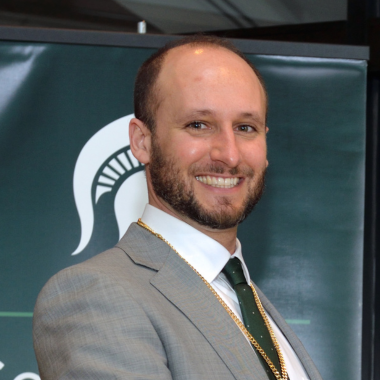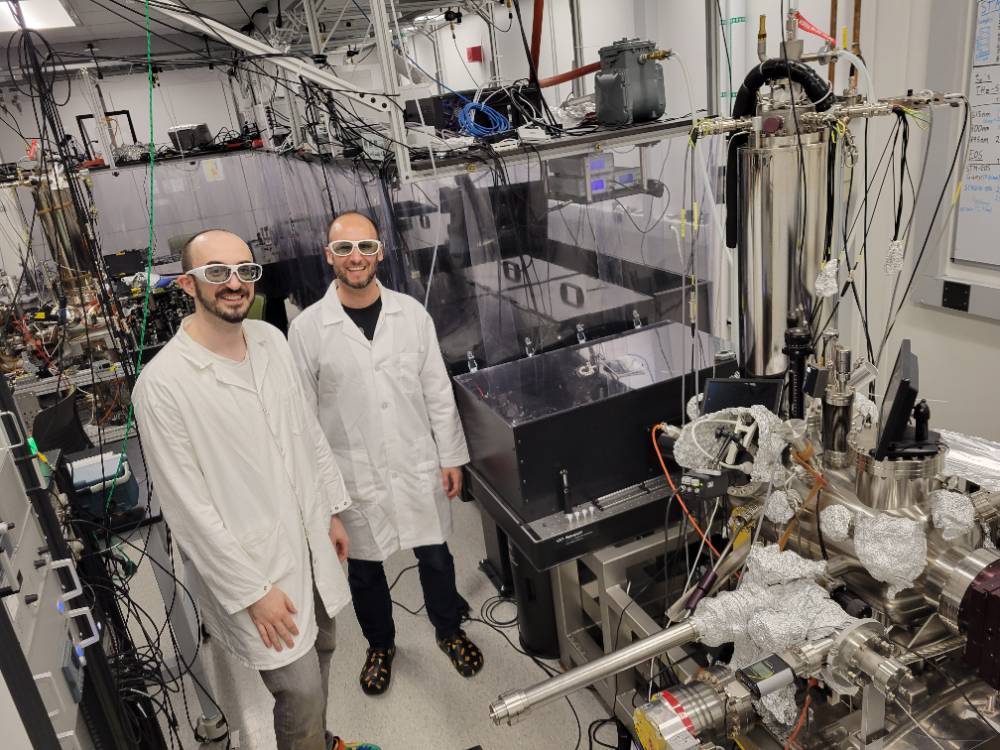Tyler Cocker earns Early Career Research Award for charting new territory in material physics
Article Highlights
- Tyler Cocker received a prestigious award from the Department of Energy for his research on atomic motion in materials.
- Cocker pioneered a technique that uses lightwave-driven terahertz scanning tunneling microscopy to observe single atoms moving in surfaces.
- Cocker's technique is gaining popularity among other researchers, with more labs building their own instruments to conduct similar studies.

Credit: Harley Seeley
Michigan State University’s Tyler Cocker received a prestigious 2024 Early Career Research Award from the Department of Energy (DOE) for research that uses a technique he pioneered to study atomic motion in materials. The DOE instituted the Early Career Research Program (ECRP) in 2010 to support the early careers of outstanding researchers, cultivate leaders in STEM, and sustain America’s place as a force of scientific discovery and innovation worldwide. “I’m extremely grateful to the Department of Energy and the reviewers who saw the potential of this project,” Cocker said. “My proposal focuses on the technique and type of science I’ve been doing for quite a long time, starting with my PhD, continuing in Germany, and now here at MSU. Although I am the recipient, this is an award for my group at MSU and my collaborators over the last decade.”
Over the next five years, Cocker, who is an Assistant Professor and Jerry Cowen Endowed Chair in Experimental Physics in the College of Natural Science, will receive $880,297.32 from the DOE to cover research costs including materials, supplies, and graduate student salaries.
“It is a great pleasure to congratulate Tyler for his Career award,” said Stephen Zepf, Chair of MSU’s Department of Physics & Astronomy. “The Career awards are designed to recognize the most promising young scientists, and Tyler richly deserves this honor. The awards also come with substantial funding which will help enable Dr. Cocker and his research group to explore new directions and make exciting breakthroughs in their field of ultrafast physics.”
A new way to see materials
Since the 1980s, researchers have been able to look at atoms sitting on a surface, but until recently atoms in motion remained unseen. Building on his work at the University of Alberta and University of Regensburg in Germany, Cocker set out to solve this problem. When he began his role at MSU in 2018, he led his lab to construct the first instrument that could watch single atoms move in surfaces. These findings were published in Nature Photonics in July.
Cocker’s technique combines two types of technology to capture the very fast and very small. (Atoms move at around 10 to the power of -12 seconds.) It uses simultaneous atomic spatial resolution and ultrafast temporal resolution using lightwave-driven terahertz scanning tunneling microscopy. Terahertz is a range between microwave and infrared in the light spectrum. To make it work, Cocker uses a microscope he had made specifically for this use and a laser fitted with optical equipment and mirrors in precise positions. By combining very short flashes of light with a needle that moves back and forth over a surface, Cocker and his group can take ultrafast movies on the scale of single atoms.
The purpose of their research is to characterize and control materials. Detailed knowledge of a material’s makeup and the ability to manipulate its atomic structure are important factors in application. Materials they study could be suitable for building faster electronic components and ultimately computers, for quantum computing, and for more efficient solar energy.

Credit: Cocker Group Lab
Illusive Kagome
Coincidence led Cocker to the complex and mysterious Kagome materials. Bonus samples of these materials arrived at his lab with a shipment for another project and a note that read “you might want to look at this.” Cocker and his team were immediately intrigued by the Kagome materials’ lattice-like atomic structure and exotic properties, and it became the focus of his Early Career project.
At the atomic level, imperfections known as defects in a material’s structure can indicate the material’s behavior under various conditions. Atomic defects in the Kagome lattice such as single-atom vacancies, where an atom is missing from its usual place in the lattice structure, could reveal key information. By understanding the makeup of Kagome materials, Cocker’s group may reveal how it can be manipulated for other purposes.
“We are the only group studying Kagome materials in this way which is not surprising since only a few people have these instruments. It is fertile ground since the technique and material are both quite new.”
A growing and rewarding field
Cocker has seen his technique begin to become a growing field of research. Since it is not super expensive to build the instrument, quite a few individual labs have used his model to build their own.
“Performing high tech experiments with my team and seeing images of individual atoms moving around is a great privilege,” Cocker said. “The constant challenges of quantum mechanical scale behavior are exciting; when you find something spectacular, and you are the first ones to ever see it, that’s really an amazing feeling, you feel like an old-fashioned explorer.”